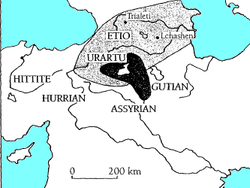Trialeti culture

The Trialeti culture was seen around the 2nd millennium B.C.[2] In the late 3rd millennium B.C. settlements of the Kura-Araxes culture began to be replaced by early Trialeti culture sites.[3] The Trialeti culture was the second culture to appear in the Caucasus, after the Kura-Araxes culture.[4] The Trialeti culture shows close ties with the highly-developed cultures of the ancient world, particularly with the Aegean.[5]
Related pages[change | change source]
References[change | change source]
- ↑ “Armenians” in Encyclopedia of Indo-European Culture or EIEC, edited by J. P. Mallory and Douglas Q. Adams, published in 1997 by Fitzroy Dearborn.
- ↑ Munchaev 1994, p. 16; cf., Kushnareva and Chubinishvili 1963, pp. 16 ff.
- ↑ The Making of Bronze Age Eurasia - Page 266 by Philip L. Kohl
- ↑ "The Alekseev Manuscript - Chapter VII - Part II: Bronze Age in Eurasia".
- ↑ "Trialeti culture". Archived from the original on 2007-09-27. Retrieved 2007-09-28.
